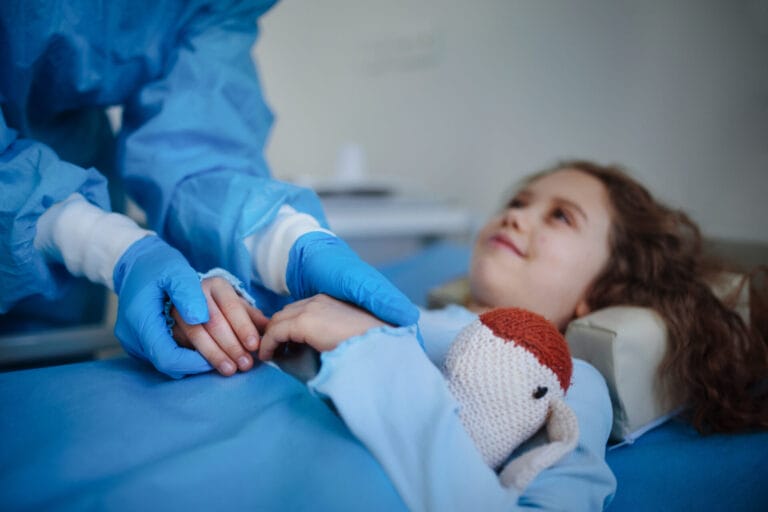Lumps and Bumps: When to See a Specialist for Skin Masses in Children
A common concern parents have is the development of unusual lumps or bumps on their child’s skin. While most skin masses in children are benign and harmless, some may require closer evaluation or surgical removal. Understanding when to seek specialist care can help you navigate these situations with confidence.
What Are Pediatric Skin Masses?
Pediatric skin masses can range from common and benign cysts to more unusual or concerning lesions. These masses may appear as small bumps under the skin, raised areas, or pigmented spots. Some are present at birth (congenital), while others develop over time.
Common Types of Pediatric Skin Masses
Children develop various types of skin growths throughout childhood, most of which are harmless. Here are some of the most frequently encountered:
- Epidermoid and sebaceous cysts. These small, slow-growing, firm lumps under the skin contain keratin and skin oils. They typically appear on the face, neck, or trunk and are always benign, though they may occasionally become infected.
- Lymph nodes. Children have many lymph nodes, particularly in the neck, groin, and armpit areas. These may enlarge during infections but usually return to normal size afterward. Persistent or significantly enlarged lymph nodes, however, warrant evaluation.
- Lipomas. These soft, movable masses consist of fatty tissue beneath the skin. Lipomas are generally harmless but may grow large enough to cause discomfort or cosmetic concerns.
- Dermoid cysts. Present at birth, these cysts often appear near the eyebrows, midline of the nose, or scalp. They contain various tissue types and may require removal to prevent infection or growth.
- Pilomatrixomas. These are firm, sometimes bluish nodules often found on the face or upper extremities. They arise from hair follicle cells and may have a hard texture due to calcification.
- Vascular anomalies. Hemangiomas (strawberry birthmarks) and vascular malformations vary in appearance and behavior. Lymphatic or vascular malformations involve the abnormal development of lymph or blood vessels, while hemangiomas are benign blood vessel growths that typically appear shortly after birth. While many hemangiomas resolve spontaneously, others may require intervention.
When to Consult a Specialist: Signs That Warrant an Evaluation
As a general guideline, you should contact your pediatrician first about your concerns. They can help determine if a referral to a pediatric surgeon, dermatologist, or other specialist is appropriate.
However, certain signs suggest it’s time to consult a pediatric specialist, particularly a pediatric surgeon who is trained to evaluate and manage these issues safely and effectively.
Pediatric Skin Mass Red Flags
Some characteristics of skin masses require prompt evaluation, typically within days. Here are key indicators that a specialist evaluation is warranted:
Persistent or Growing Mass
If a skin lump has been present for more than a few weeks without any sign of improvement—or is steadily increasing in size—this is a good reason to seek evaluation. Rapid growth, in particular, can indicate that the mass is more than a simple cyst or benign swelling. While not always dangerous, fast-growing lesions should be assessed to rule out more serious conditions or to plan for timely intervention.
In particular, masses that have grown larger than 2 cm generally warrant evaluation both for diagnostic certainty and because removal, if needed, becomes more complex as they grow. Even benign masses may be easier to address when smaller.
Pain or Tenderness
Most benign skin masses in children are painless. If your child’s lump becomes painful, tender to the touch, or inflamed, it could be a sign of infection, trauma, or internal irritation. Pain that wakes a child from sleep is particularly concerning. Pain may also signal that the mass is pressing against nearby nerves or structures. In these cases, prompt evaluation is essential to determine the cause and initiate appropriate treatment.
Changes in Color or Appearance
A sudden change in the color, shape, or texture of a skin mass, especially if it becomes red, purple, or pigmented, should prompt further investigation. Discoloration might signal internal bleeding, vascular changes, or other underlying pathology. If the skin over the mass becomes shiny, crusted, stretched, or ulcerated, it should be examined promptly.
Recurrent Infection or Drainage
Masses that repeatedly swell, become infected, or ooze pus or fluid may require surgical intervention. This is particularly common with inflamed epidermoid or dermoid cysts. Chronic drainage can also lead to scarring or skin damage if left untreated.
Firm, Fixed, or Deep Masses
Soft, mobile lumps are typically benign. However, a lump that feels firm or “stuck” under the skin may indicate that it is connected to deeper tissues. These types of masses may need imaging (such as ultrasound or magnetic resonance imaging (MRI)) and are often best evaluated by a pediatric surgeon who can determine whether pediatric skin mass removal is appropriate.
Location in Sensitive or High-Risk Areas
Masses near the eyes, scalp, spine, airway (neck), or genital area warrant extra attention. Even benign masses in these areas can cause functional problems, such as obstructed breathing, vision impairment, or neurological effects. Or, they can be technically more complex to remove. In these cases, specialized surgical planning is critical to minimize risk and preserve important functions.
Family History or Associated Symptoms
If there’s a family history of unusual skin conditions, genetic syndromes, or soft tissue tumors, a lump may warrant earlier evaluation. Likewise, if your child also has fever, weight loss, fatigue, or night sweats along with a skin mass, these could be signs of a more systemic issue and should not be ignored.
In summary, while many childhood lumps are harmless, certain red flags, such as rapid growth, pain, drainage, firmness, or sensitive location, should prompt evaluation by a pediatric specialist. Early consultation ensures accurate diagnosis, peace of mind, and timely treatment if needed.
From Concern to Clarity: What to Do If You’re Unsure About a Lump
Not every lump or bump needs surgical attention, but when they do, it’s important to consult a specialist familiar with the complexities of growing children.
Trust your instincts as a parent. If you’re unsure or have concerns about a skin mass on your child, don’t hesitate to seek evaluation from your pediatrician.
Early assessment by your pediatrician, with referral to a pediatric surgeon when appropriate, allows for a safe and effective pediatric skin mass removal and ensures your peace of mind.
This article is provided for informational purposes only and is not a substitute for professional medical advice. Always consult with your child’s healthcare provider for diagnosis and treatment recommendations.








